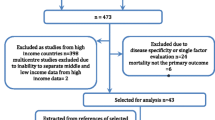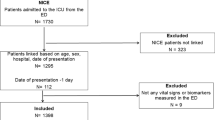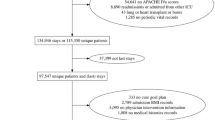Abstract
Objective
To determine the impact of missing Acute Physiology Score (APS) values on risk-adjusted mortality.
Design
Retrospective review of prospectively collected Acute Physiology and Chronic Health Evaluation (APACHE) III database.
Setting
The intensive care units (ICUs) of an academic medical center.
Patients
38,411 patients admitted to ICU between October 1994 and December 2003.
Measurements and results
Data were collected on ICU type, missing first ICU day APS values, predicted and observed hospital mortality, standardized mortality ratio (SMR), 95% confidence interval (CI), odds ratio (OR). The overall observed and predicted hospital mortality rates were 8.7% and 10.8%, respectively, with SMR of 0.806 (95% CI 0.779–0.834). Complete data were available in 829 (2.2%). Vital signs were missing in almost none and serum albumin and bilirubin in over 80% of the patients. The number of missing variables was higher in less sick and surgical ICU patients. Logistic regression analysis showed that the risk of dying in the hospital was significantly associated with the number of missing APS variables (OR 1.058, 95% CI 1.027–1.090) when adjusted for the severity of illness. The risk of death was also associated with the type of missing variables.
Conclusions
Since missing APS values may lead to underestimation of the predicted mortality rates, the number and type of missing variables should be taken into consideration when assessing the performance of an ICU. Unless data collection is standardized, future prognostic models should use variables that are routinely measured in most critically ill patients without sacrificing statistical precision.
Similar content being viewed by others
References
Knaus WA, Draper EA, Wagner DP, Zimmerman JE (1985) APACHE II: a severity of disease classification system. Crit Care Med 13:818–829
Knaus WA, Wagner DP, Draper EA, Zimmerman JE, Bergner M, Bastos PG, Sirio CA, Murphy DJ, Lotring T, Damiano A (1991) The APACHE III prognostic system. Risk prediction of hospital mortality for critically ill hospitalized adults. Chest 100:1619–1636
Knaus WA, Zimmerman JE, Wagner DP, Draper EA, Lawrence DE (1981) APACHE-acute physiology and chronic health evaluation: a physiologically based classification system. Crit Care Med 9:591–597
Le Gall JR, Lemeshow S, Saulnier F (1993) A new Simplified Acute Physiology Score (SAPS II) based on a European/North American multicenter study. JAMA 270:2957–2963
Le Gall JR, Loirat P, Alperovitch A, Glaser P, Granthil C, Mathieu D, Mercier P, Thomas R, Villers D (1984) A simplified Acute Physiology Score for ICU patients. Crit Care Med 12:975–977
Lemeshow S, Teres D, Klar J, Avrunin JS, Gehlbach SH, Rapoport J (1993) Mortality Probability Models (MPM II) based on an international cohort of intensive care unit patients. JAMA 270:2478–2486
Lemeshow S, Klar J, Teres D, Avrunin JS, Gehlbach SH, Rapoport J, Rue M (1994) Mortality probability models for patients in the intensive care unit for 48 or 72 hours: a prospective, multicenter study. Crit Care Med 22:1351–1358
Lemeshow S, Teres D, Pastides H, Avrunin JS, Steingrub JS (1985) A method for predicting survival and mortality of ICU patients using objectively derived weights. Crit Care Med 13:519–525
Lemeshow S, Le Gall JR (1994) Modeling the severity of illness of ICU patients. A systems update. JAMA 272:1049–1055
Glance LG, Osler TM, Dick A (2002) Rating the quality of intensive care units: is it a function of the intensive care unit scoring system? Crit Care Med 30:1976–1982
Knaus WA (2002) APACHE 1978–2001: the development of a quality assurance system based on prognosis: milestones and personal reflections. Arch Surg 137:37–41
Rapoport J, Teres D, Lemeshow S, Gehlbach S (1994) A method for assessing the clinical performance and cost-effectiveness of intensive care units: a multicenter inception cohort study. Crit Care Med 22:1385–1391
Zimmerman JE, Alzola C, Von Rueden KT (2003) The use of benchmarking to identify top performing critical care units: a preliminary assessment of their policies and practices. J Crit Care 18:76–86
Zimmerman JE, Wagner DP, Draper EA, Wright L, Alzola C, Knaus WA (1998) Evaluation of acute physiology and chronic health evaluation III predictions of hospital mortality in an independent database. Crit Care Med 26:1317–1326
Metnitz PG, Vesely H, Valentin A, Popow C, Hiesmayr M, Lenz K, Krenn CG, Steltzer H (1999) Evaluation of an interdisciplinary data set for national intensive care unit assessment. Crit Care Med 27:1486–1491
Engel JM, Junger A, Bottger S, Benson M, Michel A, Rohrig R, Jost A, Hempelmann G (2003) Outcome prediction in a surgical ICU using automatically calculated SAPS II scores. Anaesth Intensive Care 31:548–554
Perez A, Dennis RJ, Gil JF, Rondon MA, Lopez A (2002) Use of the mean, hot deck and multiple imputation techniques to predict outcome in intensive care unit patients in Colombia. Stat Med 21:3885–3896
Li TC, Phillips MC, Shaw L, Cook EF, Natanson C, Goldman L (1984) On-site physician staffing in a community hospital intensive care unit. Impact on test and procedure use and on patient outcome. JAMA 252:2023–2027
Afessa B, Keegan MT, Gajic O, Hubmayr RD, Peters SG (2005) The impact of missing components of the Acute Physiology Score on the standardized mortality ratio calculated by the APACHE III prognostic model. Crit Care 9:S96–S97
Afessa B, Keegan MT, Hubmayr RD, Naessens JM, Gajic O, Long KH, Peters SG (2005) Evaluating the performance of an institution using an intensive care unit benchmark. Mayo Clin Proc 80:174–180
Apolone G (2000) The state of research on multipurpose severity of illness scoring systems: are we on target? Intensive Care Med 26:1727–1729
Bosman RJ, Oudemane van Straaten HM, Zandstra DF (1998) The use of intensive care information systems alters outcome prediction. Intensive Care Med 24:953–958
Chen LM, Martin CM, Morrison TL, Sibbald WJ (1999) Interobserver variability in data collection of the APACHE II score in teaching and community hospitals. Crit Care Med 27:1999–2004
Glance LG, Osler TM, Papadakos P (2000) Effect of mortality rate on the performance of the Acute Physiology and Chronic Health Evaluation II: a simulation study. Crit Care Med 28:3424–3428
Goldhill DR, Sumner A (1998) APACHE II, data accuracy and outcome prediction. Anaesthesia 53:937–943
Polderman KH, Thijs LG, Girbes AR (1999) Interobserver variability in the use of APACHE II scores. Lancet 353:380
Polderman KH, Girbes AR, Thijs LG, Strack van Schijndel RJ (2001) Accuracy and reliability of APACHE II scoring in two intensive care units Problems and pitfalls in the use of APACHE II and suggestions for improvement. Anaesthesia 56:47–50
Polderman KH, Jorna EM, Girbes AR (2001) Inter-observer variability in APACHE II scoring: effect of strict guidelines and training. Intensive Care Med 27:1365–1369
Rosenberg AL, Hofer TP, Strachan C, Watts CM, Hayward RA (2003) Accepting critically ill transfer patients: adverse effect on a referral center’s outcome and benchmark measures. Ann Intern Med 138:882–890
Rosenberg AL (2002) Recent innovations in intensive care unit risk-prediction models. Curr Opin Crit Care 8:321–330
Suistomaa M, Kari A, Ruokonen E, Takala J (2000) Sampling rate causes bias in APACHE II and SAPS II scores. Intensive Care Med 26:1773–1778
Keulen JG van, Polderman KH, Gemke RJ (2005) Reliability of PRISM and PIM scores in paediatric intensive care. Arch Dis Child 90:211–214
Zanten AR van, Polderman KH (2004) Organizational changes in a single intensive care unit affect benchmarking. Ann Intern Med 140:674–675
Champion HR, Sacco WJ (1982) Measurement of patient illness severity. Crit Care Med 10:552–553
Fery-Lemonnier E, Landais P, Loirat P, Kleinknecht D, Brivet F (1995) Evaluation of severity scoring systems in ICUs-translation, conversion and definition ambiguities as a source of inter-observer variability in APACHE II, SAPS and OSF. Intensive Care Med 21:356–360
Zimmerman JE (2002) Measuring intensive care unit performance: a way to move forward. Crit Care Med 30:2149–2150
Author information
Authors and Affiliations
Corresponding author
Additional information
This article refers to the editorial: http://dx.doi.org/10.1007/s00134-005-2750-x
Rights and permissions
About this article
Cite this article
Afessa, B., Keegan, M.T., Gajic, O. et al. The influence of missing components of the Acute Physiology Score of APACHE III on the measurement of ICU performance. Intensive Care Med 31, 1537–1543 (2005). https://doi.org/10.1007/s00134-005-2751-9
Received:
Accepted:
Published:
Issue Date:
DOI: https://doi.org/10.1007/s00134-005-2751-9




